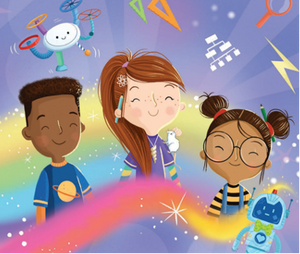As a STEM educational children’s publisher, we are SUPER excited about National Robotics Week (3rd – 11th April) which aims to inspire a love of robotics and STEM-related careers in young people. We’re going to tell you a little bit about robots (and why they are SO COOL!) and then leave you with some awesome free activities you can use to help your 4–9-year-olds develop an interest in STEM (Science, Technology, Engineering and Mathematics).
So, what is a robot? To put it simply, a robot is a machine that moves, or has moving parts, and makes decisions while it interacts with the world. You may not realise it, but robots play a HUGE role in our lives. Car manufacturers have been using them for years to make cars safer, faster and better; operational companies use them to carry the heavy loads that humans couldn’t physically bear themselves; farmers use them to help harvest more efficiently; nurses, paramedics and doctors use robot patients to help their student health workers practice diagnosis and treatment of various conditions before they go near real patients…the list is endless! Robots are therefore pretty amazing things – they help save lives, advance society and improve our world.
This is why robotics (the study of robots) is so exciting and will change our future. Robots need a lot of smart humans to build them and to develop their AI (Artificial Intelligence) and these people – called ‘roboticists’ – require expertise in maths, physics, design, computing, and mechanical engineering to name but a few. We believe that the earlier children are exposed to these STEM skills in a fun and interactive way, the more chance they have of developing an interest in areas like robotics. It’s especially important that young girls are helped to view robotics and other STEM fields as something they can be a part of and excel in – we need to break the stereotype that careers like robotics are “only for men”.
In fact, if you have young girls, you may want to tell them about Dr Merritt Moore – a ballerina AND physicist! This remarkable woman openly campaigns for more females to enter STEM fields and for subjects like robotics to be taught in a more interesting way. We love the fact that this “quantum ballerina” hasn’t had to make a choice between the arts and science – showcasing that girls CAN do both.
So, to get your little innovators excited about robots, we’ve created some free activity sheets which will help them to develop their STEM skills in a fun, interactive way.
In this stylish activity, children aged 4 – 5 will need to use their pattern matching skills to draw a line between each matching bow tie and magnifying glass.
These fun activities help children aged 4 - 8 to develop their STEM problem-solving skills.
Children of all ages will enjoy this drawing activity in which they’ll need to design a friend for B-bot. We’d love to see your designs so please Tweet them to @QuestFriendz using the hashtag #BBotActivity!
This is a really fun game that you can play with a friend or a family member. One of you can pretend to be Detective B-bot who is searching for hidden treasure and the other can program him to find the treasure using simple instructions. It’s a great way to get children interested in coding from a young age!
This is a slightly harder (but still super fun!) challenge for children aged 6-9 to try to crack. To repair our beloved B-bot they’ll need to use their STEM problem-solving skills.
At QuestFriendz we believe that imaginative and hands-on purposeful play, when combined with problem-solving through play, are key to providing young children with an engaging and memorable experience. Starting STEM at an early age helps children to make important connections between everyday life and the STEM disciplines. Addressing young children also allows us to harness their natural curiosity. This magical state helps to accelerate learning including STEM learning. Children become better equipped to face a fast-paced and evolving world, when problem-solving skills and learning to fail are introduced from a young age.
We’ll be sharing some more of our favourite STEM educational quests for parents to try out with their kids at home or for teachers to try in the classroom. Stay tuned!















